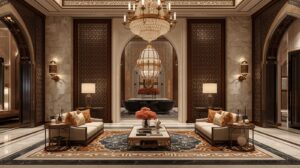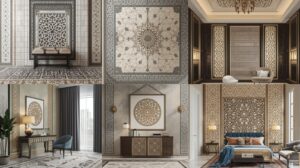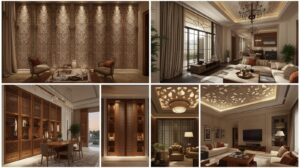Dubai’s design scene is known for blending tradition with innovation. Among the most admired styles, Arabic interior design in Dubai stands out for its timeless beauty, cultural depth, and unique craftsmanship. Rooted in centuries-old traditions yet adapted for modern homes, it combines elegance with functionality.
In 2025, homeowners are particularly drawn to geometric elements and Mashrabiya trends, which add character, privacy, and sophistication to villas, apartments, and penthouses across the UAE.
In this blog, we’ll explore why Arabic interior design in Dubai is gaining popularity and how geometric details and Mashrabiya-inspired patterns are shaping the future of luxury interiors.
What Defines Arabic Interior Design in Dubai?
At its heart, Arabic interior design in Dubai draws inspiration from Islamic art and Middle Eastern architecture. The design reflects balance, order, and beauty through intricate detailing and natural harmony.
Key features include:
- Symmetrical geometric patterns that symbolize balance and infinity.
- Mashrabiya screens – traditional wooden latticework for privacy and ventilation.
- Rich color palettes inspired by desert landscapes and Arabian heritage.
- Luxurious materials such as marble, brass, carved wood, and mother-of-pearl.
- Statement lighting with lanterns, pendants, and chandeliers.
This style brings warmth, elegance, and a sense of cultural identity into Dubai’s modern homes.
The Rise of Geometric Patterns
Geometry is at the heart of Islamic art and therefore a defining feature of Arabic interior design in Dubai. Unlike random decoration, geometric patterns are carefully constructed to create rhythm, unity, and spiritual harmony.
In modern interiors, geometric patterns appear in:
- Flooring: intricate marble inlays or mosaic tiles.
- Ceilings: decorative panels with geometric carvings.
- Furniture: tables, consoles, and headboards with geometric inlays.
- Wall art & partitions: laser-cut designs inspired by Islamic motifs.
Homeowners prefer geometric details because they offer both artistry and structure, making them ideal for villas and luxury apartments.
Mashrabiya Trends in Modern Interiors
The Mashrabiya—a traditional lattice screen—was originally used in Middle Eastern homes to provide privacy while allowing airflow and light. Today, Mashrabiya trends are being reinterpreted in modern Arabic interior design in Dubai.
Modern applications include:
- Feature walls – Mashrabiya panels as statement backdrops in living rooms.
- Balconies & terraces – carved wood or metal screens for shade and privacy.
- Partitions – room dividers that separate open-plan spaces elegantly.
- Wardrobes & cabinetry – Mashrabiya-inspired doors for storage units.
- Ceilings & lighting – panels with intricate cutouts casting dramatic shadows.
The fusion of Mashrabiya with contemporary design creates interiors that are both culturally rich and visually stunning.
Why Arabic Interior Design in Dubai Works for Modern Homes
Unlike many global styles that fade with trends, Arabic interior design in Dubai continues to thrive because it balances tradition and modern living.
Here’s why it’s perfect for Dubai homes:
- Cultural connection: celebrates heritage while fitting into today’s lifestyle.
- Adaptability: works in villas, apartments, hotels, and offices alike.
- Luxury appeal: geometric and Mashrabiya details create an aura of exclusivity.
- Climate suitability: screens and patterns help with light, airflow, and comfort.
This makes it one of the most sustainable and meaningful choices for interiors in the UAE.
Key Materials & Colors in Arabic Interiors
When designing with Arabic interior design in Dubai, materials and colors play a vital role in authenticity:
- Colors: deep blues, earthy terracotta, warm golds, and emerald greens.
- Materials: carved wood, polished brass, marble, natural stone, and ceramics.
- Textures: patterned textiles, handwoven rugs, and plush upholstery.
Together, these create interiors that feel vibrant, luxurious, and deeply rooted in Arabian culture.
Tips for Bringing Arabic Design into Your Home
If you’re planning to incorporate Arabic interiors design in Dubai, here are some ideas:
- Add a Mashrabiya partition to define open spaces stylishly.
- Use geometric tiles in kitchens or bathrooms for cultural depth.
- Introduce lantern-style lighting for a warm, atmospheric glow.
- Combine bold colors with neutral backdrops for balance.
- Work with expert interior designers to create authentic yet modern spaces.
By blending tradition with modern functionality, you can design a home that feels both luxurious and culturally rich.
Read more on Textured Interiors & Art Deco Revival in Dubai: Bold Statement Walls and Luxury Trends for 2025
Final Thoughts
The beauty of Arabic interior design in Dubai lies in its ability to merge heritage with modernity. With geometric patterns and Mashrabiya trends, homes in Dubai are becoming expressions of cultural pride and refined luxury.
At Interiofy, we specialize in creating interiors that bring the richness of Arabic design into today’s lifestyle. From luxury villas to contemporary apartments, our team blends tradition with modern innovation to deliver timeless spaces.
Ready to transform your home with Arabic interior design in Dubai? Contact Interiofy® today and let’s craft a home that celebrates culture, elegance, and modern comfort.


